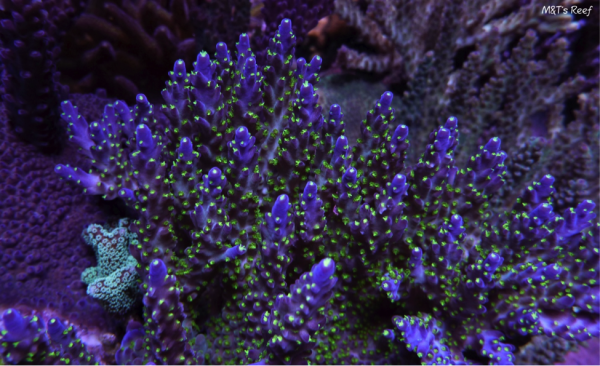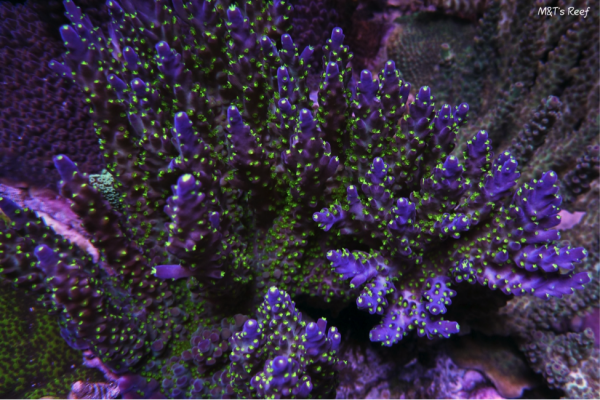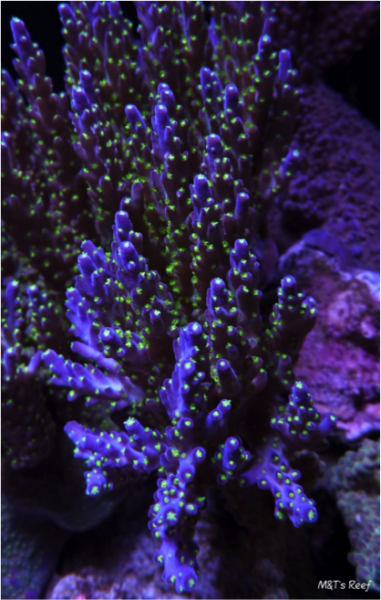Acropora Secale: The Buff Beauty
By Mike Lauderdale
Acropora secale is buff. It works out. Not like a “10 minutes on the treadmill” kind of work out, either. This coral is one of the most dense that I have ever kept in my system. It is a high-energy, high-output kind of coral. It obviously loves to consume high amounts of calcium and other ions essential for building its really heavy and thick skeleton. Likewise, it loves high-intensity light and wave action. Like Acropora humilis, A. secale is one of the heavyweights of the reef builders.
Acropora secale is abundant in the South Pacific Ocean, particularly in the central Indo-Pacific and along the Great Barrier Reef1. This is a good thing, because A. secale is a dense branching coral that helps build the essential reef structures that are so vital to aquatic ecosystems. Most A. secale are shallow-water animals, preferring to colonize in the reef flats and upper reef slopes in water depths less than 15 ft. It is in these brutal areas where barrier reefs form to provide their important function of protecting the mainland from the ravages of the ocean’s grinding forces.
This great utility of the secale is probably not something that we, as reef keepers, care too much about. We don’t love secale for its usefulness, we love secale for its gorgeous looks and shape.
Since it is a shallow-water coral, it gets hit with a lot of full-on sun. It also happens to possess a cyan fluorescent protein (CFP), which gives it a wonderful blue/green fluorescence when exposed to blue light2. The coral has the dramatic deep bluish-purple skin coloration, often with a bright contrasting color in the polyp tentacles.
As previously mentioned, A. secale is typically a dense, bushy (“caespitose”) growth form. This means that it will usually be heavily encrusting with thick branches that tend to grow close together. All of this adds up to a very handsome SPS coral for our tanks.
Acropora secale is a hermaphrodite, i.e., it possesses male and female reproductive organs. Colonies release eggs and sperm simultaneously, typically once per year in a predictable lunar cycle3. This allows it to be fairly successful at not only propagating itself locally, but also over fairly long distances as ocean currents carry their gametes. There have been increasing numbers of reported spawning events in captivity in recent years as hobbyists deploy sophisticated equipment capable of replicating natural conditions in their systems.
Good news for us hobbyists is that secales are plentiful in the wild and often available in the trade. Many coral famers are actively aquaculturing or mariculturing A. secale, which makes it frequently available and reasonably priced.
Quick Stats
- Care level: medium/difficult
- Lighting: high/high
- Placement: top
- Flow: high
- Temperature: 72 to 80 F
- Alkalinity: 7 to 11 dKH
- pH: 7.8 to 8.3
- Salinity: 1.023 to 1.026
Summary
A. secale is a beautiful and plentiful species that can be a hardy choice for the seasoned SPS keeper. When provided with stable water parameters, along with strong lighting and flow, it will make a fantastic addition to your system. Get yourself a nice maricultured piece from a reputable retailer and be inspired by the coral that is both buff and beautiful!
References:
1 Australian Institute of Marine Science
2 Aquarium Corals: Making Corals Colorful
3 Staghorn Corals of the World
Author
Mike has been keeping marine aquariums since 1984. Mike and Terry’s current system is a 300g SPS-dominated reef that is home to a large variety of reef safe fish. Their freelance writing and photographs have been published in several online and print magazine publications.




Leave a Reply
You must be logged in to post a comment.